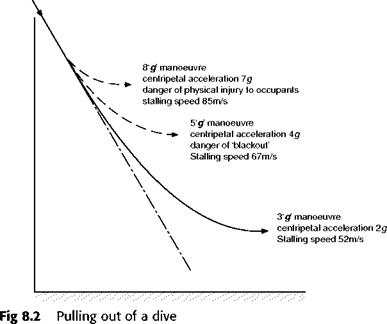Pulling out of a dive
We have already looked at one example involving a pull-out from a dive. Let us now look at some of the effects of this manoeuvre. Firstly, we have seen that the wings will have to generate more lift, in order to provide the necessary centripetal acceleration. This means that the bending stresses in the wing will increase. In fact, in a 3 ‘g’ pull out, they will be three times as high as for normal level flight. Design and safety requirements and regulations will specify the maximum load factor that the aircraft must be able to withstand, and all the stresses in the aircraft have to be determined for this condition. The required load factor will depend on the usage. Fully aerobatic types have a high specified maximum load factor, whereas civil transports have a lower requirement. You are not allowed to roll or loop airliners, although a roll has been performed on at least one occasion (without any passengers present). The pilot will be made aware of the maximum number of ‘g’s that the aircraft is permitted to be subjected to.
In order to provide the necessary increase in lift, the lift coefficient CL must be increased by increasing the angle of attack. This in fact goes up as the square root of the ‘g’ factor. Clearly, there can come a point where the maximum CL is reached, and any attempt to further increase it will result in
 |
4
the aircraft stalling. The greater the centripetal acceleration required, the higher will be the stalling speed. Stalling whilst attempting to pull out too steeply is a condition that pilots must avoid at all times. The consequences can be disastrous, as many dive-bomber pilots have found to their cost. Figure 8.2 illustrates the case of an aircraft, having a level flight stalling speed of 30 m/s, pulling out of a steep dive. The load factor or ‘g’ level, the stalling speed and the centripetal accelerations are given for various cases.
Apart from the loads on the airframe, any manoeuvre involving large centripetal accelerations will have a physical effect on the pilot. The pilot’s head will feel heavy, and he will experience difficulty in moving his arms, which now feel several times heavier than normal. Even at 1.5 ‘g’s, writing becomes difficult. Worse than this, however, are the effects that the centripetal acceleration can have on his blood circulation. At around 4 to 5 ‘g’, his heart, which is a pressure pump, will start to have difficulty pumping blood to his head, and if this is too severe, everything will appear to turn grey at first, and then he will be in danger of ‘blacking out’ and losing consciousness.
Apart from the problem of stalling, this physiological factor also imposes a limit on the severity of the manoeuvre that can be performed. In fighter aircraft, several means have been employed to increase the amount of centripetal acceleration that can be tolerated. One simple approach is to have the pilot lying as near to horizontal as possible whilst still being able to see where he is going. Another involves the use of special ‘g’ suits which inflate at strategic points to temporarily restrict the flow of blood from the head. Ultimately, for extreme manoeuvres, the only way to overcome the limitations of human physiology is to remove the pilot and use an unmanned air vehicle (UAV), either remotely controlled, or even as an autonomous robot.











